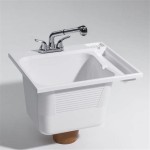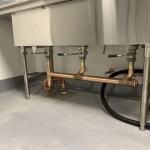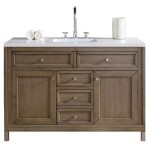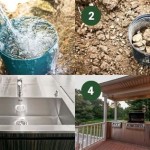Bathroom Vanity With Glass Bowl Sink: A Comprehensive Guide
The bathroom vanity with a glass bowl sink represents a merging of functionality and aesthetics, offering a visually striking and practical addition to any bathroom space. This design choice is more than just a trend; it’s a conscious decision to elevate the bathroom from a purely utilitarian area to a personal sanctuary. Understanding the nuances of this design element, from the selection process to installation and maintenance, is crucial for ensuring satisfaction and longevity.
The popularity of glass bowl sinks has surged in recent years, driven by their sleek appearance and the ability to complement a wide range of bathroom styles, from modern minimalist to rustic chic. The transparent nature of the glass allows for a visual lightness that can make smaller bathrooms feel more spacious. Furthermore, the varied shapes, sizes, and colors available provide ample opportunity for customization, enabling homeowners to personalize their bathrooms in unique ways.
When considering a bathroom vanity with a glass bowl sink, several factors must be taken into account. These encompass the aesthetic appeal, the structural integrity of both the vanity and the sink, the plumbing considerations, the ease of maintenance, and, of course, the budget. A thorough understanding of these aspects will facilitate a well-informed decision, resulting in a bathroom that is both beautiful and functional.
Key Considerations Before Purchasing
Before embarking on the journey of acquiring a bathroom vanity with a glass bowl sink, a careful assessment of needs and preferences is paramount. This initial stage sets the foundation for a successful and satisfying outcome. Several key factors warrant specific attention:
1. Space and Layout: The dimensions of the bathroom will dictate the size and configuration of the vanity. A small bathroom will benefit from a compact vanity with a single sink, while a larger bathroom might accommodate a double vanity with dual glass bowl sinks. Consider the traffic flow within the bathroom and ensure that the vanity placement does not impede movement. Measure the available space precisely and note the location of existing plumbing connections, as these will influence the installation process.
2. Style Compatibility: The style of the bathroom vanity should harmonize with the overall aesthetic of the bathroom. Consider the existing color palette, the style of the fixtures (faucets, showerheads, towel racks), and the architectural details of the space. Glass bowl sinks are versatile and can be integrated into various design schemes, but careful consideration should be given to the materials and finishes of the vanity cabinet itself. For example, a rustic wooden vanity paired with a clear glass bowl sink can create a charming contrast, while a sleek, minimalist vanity with a frosted glass bowl sink can evoke a contemporary feel.
3. Practicality and Usage: Evaluate the intended use of the bathroom. Is it a master bathroom used daily by multiple individuals, or a guest bathroom used less frequently? The frequency of use will influence the choice of materials and the durability required. For high-traffic bathrooms, opt for robust materials that can withstand daily wear and tear. Consider the storage needs as well. Does the vanity provide sufficient storage space for toiletries, towels, and other bathroom essentials? If storage is a priority, look for vanities with ample drawers and cabinets.
Selecting the Right Components: Vanity and Sink
Once the initial considerations are addressed, the next step involves selecting the specific components: the vanity cabinet and the glass bowl sink itself. This phase requires a detailed understanding of the materials, styles, and functionalities available.
1. Vanity Cabinet Materials: The vanity cabinet serves as the foundation for the glass bowl sink and must be constructed from durable, water-resistant materials. Common materials include solid wood, plywood, MDF (Medium-Density Fiberboard), and particleboard. Solid wood is the most durable and aesthetically pleasing option but can be more expensive. Plywood offers a good balance of strength and affordability. MDF and particleboard are less expensive but are also more susceptible to water damage. Ensure that the cabinet is properly sealed and finished to protect it from moisture. Consider the finish as well, such as paint, stain, or laminate, and choose one that complements the overall design scheme. The hardware, such as knobs and pulls, should also be selected with care, as they contribute to the overall aesthetic appeal.
2. Glass Bowl Sink Styles and Materials: Glass bowl sinks are available in a wide array of styles, shapes, and colors. Common shapes include round, square, rectangular, and asymmetrical designs. The choice of shape depends on personal preference and the overall aesthetic of the bathroom. Clear glass bowls are the most classic and versatile option, but frosted, tinted, and textured glass bowls are also available. The thickness of the glass is an important consideration. Thicker glass is more durable and less prone to chipping or cracking. Tempered glass is a particularly good choice, as it is stronger and more resistant to thermal shock. Consider the height of the bowl as well, as a taller bowl may require a shorter faucet to prevent splashing.
3. Faucet Selection and Compatibility: Selecting the right faucet is crucial for both functionality and aesthetics. The style of the faucet should complement the design of the vanity and the sink. Common faucet styles include single-handle, double-handle, and widespread faucets. The height of the faucet spout is also important. A taller spout is necessary to reach over the rim of the glass bowl sink, but it should not be so tall that it causes splashing. Ensure that the faucet is compatible with the plumbing connections and that it meets all relevant plumbing codes and standards. Consider the finish of the faucet as well, such as chrome, brushed nickel, or oil-rubbed bronze, and choose one that complements the other fixtures in the bathroom.
Installation and Maintenance
The installation of a bathroom vanity with a glass bowl sink requires careful planning and execution. Proper installation is essential for ensuring the longevity and functionality of the vanity and sink. Similarly, regular maintenance is crucial for preserving the beauty and preventing damage.
1. Professional vs. DIY Installation: Depending on the level of experience and comfort, the installation can be performed either professionally or as a DIY project. Professional installation is generally recommended for complex installations or when dealing with unfamiliar plumbing systems. A qualified plumber will ensure that the vanity is properly installed, the plumbing connections are secure, and the sink is properly sealed to prevent leaks. DIY installation can be a cost-effective option for experienced homeowners, but it requires careful planning, attention to detail, and adherence to all relevant plumbing codes and standards. Before attempting a DIY installation, thoroughly research the installation process and gather all the necessary tools and materials.
2. Plumbing Considerations: The plumbing connections for the vanity and sink must be compatible with the existing plumbing system. Ensure that the water supply lines and drainpipe are properly sized and located. The drainpipe for a glass bowl sink typically connects to a P-trap, which prevents sewer gases from entering the bathroom. The P-trap should be installed according to local plumbing codes. Consider the placement of the drainpipe carefully, as it can affect the aesthetics of the vanity. Some vanities have open shelves or exposed plumbing, which requires careful attention to detail. The faucet should be connected to the water supply lines using flexible connector hoses. Ensure that the hoses are properly tightened to prevent leaks.
3. Cleaning and Maintenance: Glass bowl sinks require regular cleaning and maintenance to preserve their beauty and prevent stains or buildup. Use a mild soap and water solution to clean the sink regularly. Avoid using abrasive cleaners or harsh chemicals, as they can scratch or damage the glass. A soft cloth or sponge is ideal for cleaning the sink. Rinse the sink thoroughly with water and dry it with a clean towel. To prevent water spots, consider using a glass cleaner specifically designed for bathroom fixtures. Regularly inspect the plumbing connections for leaks and address any issues promptly. Clean the vanity cabinet with a damp cloth and mild soap. Avoid using excessive water, as it can damage the wood or laminate. Inspect the cabinet hardware regularly and tighten any loose screws or knobs.
By carefully considering these aspects of space, style, material selection, and installation, the integration of a bathroom vanity with a glass bowl sink can dramatically enhance both the aesthetic appeal and the functional utility of the bathroom space.

Cambridge Plumbing 8111b Bn 36 In Bathroom Vanity Set

Cambridge Plumbing 8119bxl 71 In Bathroom Vanity Set

Walsport 36 4 In W X 21 7 D 60 H Single Sink Bath Vanity White With Glass Countertop And Round Bowl Mirror Usbr4197 Usbr4184 Usbr4362 The Home

Jwh Living Furniture By Category Size 39 Inch Bathroom Vanities Quot Lune Single Glass Vessel Vanity White Top

W 36inch Bathroom Vanity With Sink Combo Modern Black Cabinet Tempered Glass Vessel Bowl Faucet Drain Wal Com

Bathroom Vanities Vanity Furniture Cabinets Rgm Distribution

Copper Glass Bowl Sink Brown Marble Vanity Dark Wooden Cabinet Round Mirror Of What You Do On S Bathroom Decor Apartment Design

W 36inch Bathroom Vanity With Sink Combo Modern Black Cabinet Tempered Glass Vessel Bowl Faucet Drain Wal Com

Modern Bathroom Glass Bowl Clear Vessel Sink Wood Vanity W Shelfs Faucet 25 In Home Garden Eba Cabinet

White Wood And Tempered Glass Vessel Sink Vanity Set







